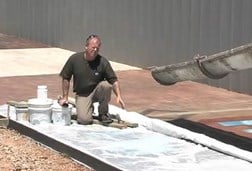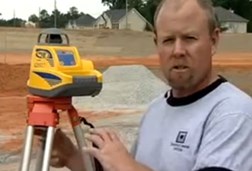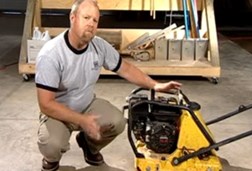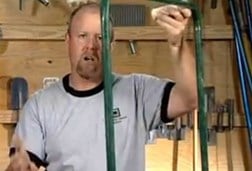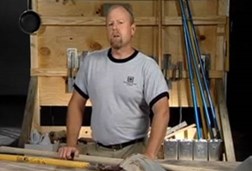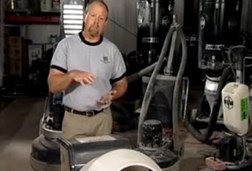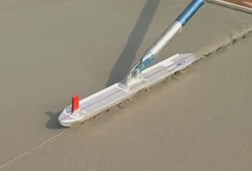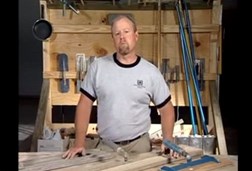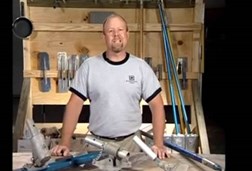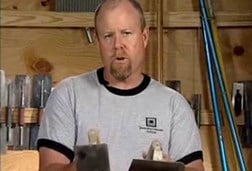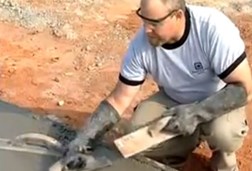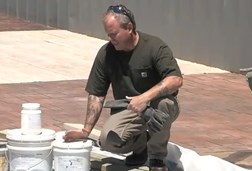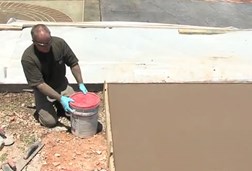- Countertop Tools
- Pouring & Finishing
- Coloring Tools
- Overlay Tools
- Polishing Tools
- Saws & Engravers
- More Concrete Videos
- Floor Videos
- Countertop Videos
- Outdoor Living Videos
- Furniture Videos
- Demonstration Videos
- Concrete Tool Videos
- Concrete Stain Videos
- Sealer Videos
- Concrete Stencil Videos
- Concrete Stamps Videos
- Surface Preparation Videos
- Concrete Forms Videos
Concrete Pouring & Finishing Videos
Watch videos that demonstrate how to properly pour concrete. Get tips on what tools are used and how to use each tool when pouring concrete.
Placing & Finishing Integrally Colored Concrete
Time: 06:03
See the tools and techniques for proper placing, screeding, floating and finishing of an integrally colored concrete slab. Also get advice on controlling evaporation and curing the concrete.
Concrete Pumping - Tips on Pouring Concrete with Pumps
Time: 03:19
Concrete contractors often use a concrete pumping company to place concrete for driveways, patios, pool decks, walkways and other outdoor slabs inaccessible by a ready-mix truck. Get tips from a professional pumping contractor on what to consider in terms of mix design, hose diameter and length, maximum aggregate size and cleanup.
Levels
Time: 05:06
A builder's level or laser level is used when forming concrete to ensure the proper amount of "fall" or slope on the formwork. The purpose of using the level is to make sure the proper amount of slope is present to prevent water or other liquids from sitting on the concrete surface. Using the traditional builder's level is just as good a technique as using a laser level, however it takes a minimum of two people to operate. When using the one person laser level on the job site, be sure all adjustments are tightened and that the tripod stakes are secure. Align the story pole flush with the top of where the new slab will be. Begin moving the sensor up or down along the story pole until you hear beeping which indicates that you are level. Next, move out to your grade stake, the lowest point of the formwork, and raise or lower the story pole until you hear beeping. Mark the grade on the formwork. The pencil line represents a level line with the highest point of the slab. Use this line to determine how much fall you want on the slab.
Plate Compactor
Time: 02:18
Proper preparation of the concrete subgrade is vital to the long term performance of the concrete slab. To prevent cracking and sinking of the slab, a plate compactor is used to compact the crushed run of aggregate base. This base is usually the thickness of the concrete slab. If the slab is four inches thick, the crushed aggregate base should be four inches thick as well. The aggregate should be sprayed with water and compacted with the vibratory plate compactor before the concrete is placed on top. Be sure to use proper safety equipment like steel toe boots, ear plugs, and eye protectors.
Tamper
Time: 01:50
The concrete tamper, or jitterbug as it is sometimes called, is used to embed aggregates down into the concrete mix. It is typically used on a "harsh mix"-a mix that has large aggregate. Use the tamper to push the aggregate into the slab, being sure to fill in voids left by your footprint in the mix.
Come-a-Long
Time: 01:56
The Come-A-Long is used to push or pull concrete into place along the screed board or formwork edge. Concrete finishers may also use a square point shovel, instead of a Come-a-long, to place the concrete before a screed is used. However, never use a shovel to lift the concrete; this is much too strenuous on your back. Rubber safety gloves and eye protection should be worn whenever you are placing concrete. Also, concrete is very caustic and will burn your skin. Use the Come-A-Long to move concrete from the high areas of the slab to the low areas to create a generally flat surface before the strike-off process begins.
Concrete Set Retardants
Time: 02:27
Prepackaged bags of concrete set-retarder admixtures are handy when you want to delay the setting time of concrete so you have more time for stamping and finishing. Learn more about the benefits of a set retardant and how to add it to fresh concrete at the jobsite.
Mix-N-Go Portable Concrete Mixer
Time: 04:18
The Mix-N-Go Portable Concrete or mortar mixer is often used for smaller concrete jobs like walkways, patios or concrete countertops, where ordering concrete from a local ready mix supplier is not economically viable. These types of mixers are used for pre-cast countertops and cast-in-place counters. These mixers hold about 3 to 4 bags of pre-bagged concrete mix and usually mix the concrete in a few minutes. Always remember to pour water into the mixer before pouring in the bag of concrete or mortar mix. Be sure to follow safety procedures and never stick your hand, or trowels inside the moving mixing drum.
Concrete Groover Video - Installing Control Joints
Time: 03:11
There are a variety of jointers and groovers that concrete finishers work with to cut contraction or control joints in a concrete slab. This is done to ensure that the concrete slab cracks at the control joint instead of in the middle of the slab. Hand groovers, walking jointers, hand chisels, or walking groover can be used to put joints in the concrete surface. To begin, snap a straight line in the fresh concrete slab to use as a guideline when cutting the control joint. Be sure that the groover you are using will cut a joint that is one quarter of the slab's depth. For example, if the slab is 4 inches thick, the control joint should be cut 1 inch deep. With a harsh mix you may need to use the groover several times in addition to closing the control joint with concrete paste. Meaning, you should take a composite float to move paste into the joint and repeat the grooving process.
Bull Floats
Time: 02:46
Bull floats serve several specific functions when finishing a concrete slab, including consolidating the slab by pushing aggregates into the center of the concrete and bringing paste to the surface. More importantly, bull floats level the surface of the concrete by cutting the high points in the concrete and filling the lows. Bull floats are typically made of wood or magnesium (referred to as a 'mag float'). According to the American Concrete Institute (ACI) flatwork finisher guidelines, magnesium floats should be used when an air entraining admixture is present in the concrete mix. Because air entraining admixtures tend to bleed less than a standard concrete mix, magnesium floats leave the seal intact, or close the concrete surface.
Fresno
Time: 03:13
Fresno concrete finishing tools are used to flatten and seal the concrete surface. This is one of the last tools used when finishing a new concrete slab. Fresnos allow finishers to trowel the middle of the slab while the concrete is still green. There are several types of fresnos that can be used depending on the type and size of concrete job. Small fresnos, known as funny trowels, are used for finishing smaller surfaces while larger fresnos, known as swivel head trowels, are used on large slabs. Some trowels have swivel heads and come with several pole attachments, which allow a finisher to stretch the fresno more than 30 feet into the center of the concrete slab. Be sure not to use a fresno too early in the finishing process, first allow all the bleed water to escape.
Edging Tools
Time: 03:07
An important consideration when selecting your edging tools is the radius of the trowel's edge. The commonly used edger has a radius of ¼ inch to ½ inch. Edging tools also come in modified forms for finishing concrete countertops or as a combination edger/groover. Walk-behind edging tools are great for increasing productivity as well as decreasing the strain on the concrete finisher's body. Walk-behind edging tools are simply standard edgers attached to a pole. Begin by cleaning the form edge. When you begin edging the slab make sure the trowel is flat. The last thing you want is a slab with uneven edges that may hold water or look wavy.
Hand Floats & Darbies
Time: 03:49
There are several types of hand floats and darbies that are used throughout the finishing process each serving a specific purpose. Generally speaking these hand floats and darbies come in three types of materials: wood, resin (composite), and magnesium. Darbies work the same way as floats except they cover more surface area because they are much longer. The wood hand float is used around the concrete slab's edge to consolidate aggregate and bring the paste to the edge of the slab. The wood float leaves the surface torn, or open, allowing the bleed water to leave the concrete. It is very critical to leave the surface open so all bleed water escapes before it is sealed. The resin or composite float has properties of both the wood float and the magnesium float; meaning it leaves the surface open but not as torn as the wood float. The magnesium floats are often used with concrete that contains air entraining admixtures. This type of float seals the concrete surface trapping both the air and bleed water.
Integral Color: When & How It's Used
Time: 04:51
Learn about the various forms of integral color (liquid vs. dry) and how to achieve the best results when using integral color. For most projects, integral pigments should be added at the batch plant for consistent, cohesive color. In addition, no water should be added to the mix at the jobsite, which can dilute the color.
Tips for Applying Color Hardeners
Time: 04:29
Dry-shake color hardeners can be used alone or with integral color to achieve more intense color effects. Harris demonstrates how to apply a dry-shake concrete color hardener to fresh concrete before stamping. Get tips for broadcasting the powder evenly across the surface and how to work it into the surface with a float or trowel.
